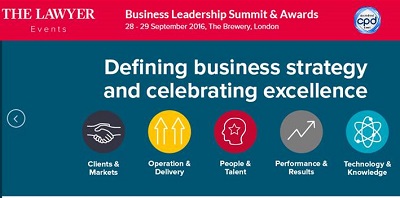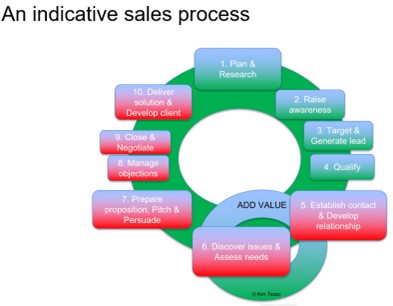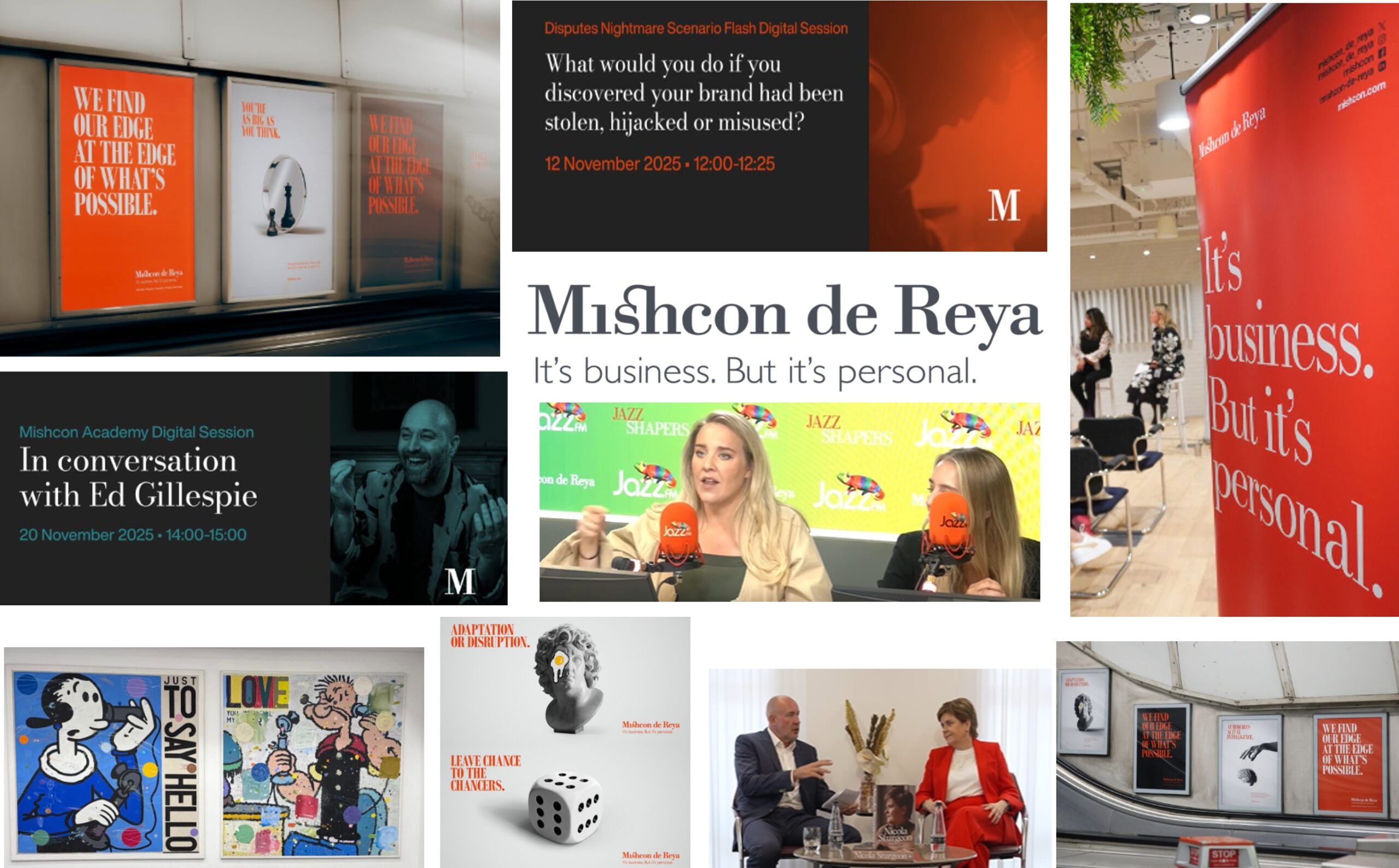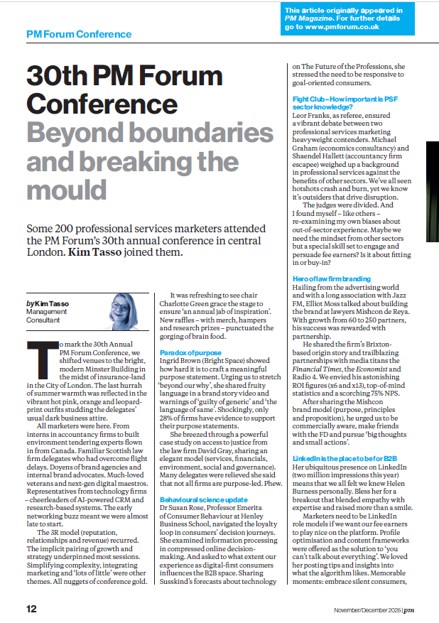
The end of September marks the annual Business Leadership Summit and Awards from The Lawyer magazine so I was at The Brewery in Chiswell Street bright and early for a day of commercial insights from lawyer business leaders. I was not disappointed.
What is the office for? – The Lawyer Workspace Trends Report
Matt Byrne, Deputy Editor of The Lawyer, kicked off proceedings sharing highlights of the 2016 Workshop Trends report which is sponsored by JLL. Of course, having spent my summer crunching the data and visiting firms to explore old and new offices meant that I was familiar with the material. So here’s a summary I prepared earlier http://kimtasso.com/lawyer-uk-200-workspace-report-lawyers-and-real-estate/
Futurologist – The 6Ds shaping the future of work
A rather animated psychologist-cum-futurologist Dr Nicola Millard (Twitter @DocNicola) was up next.
As head of customer insight and futures at BT Global Services Innovation team she provided a whirlwind tour of the 6 Ds shaping the future of work (Dilbert, Diversity, Dolly, Dr No, Droid and Distance). There was an exploration of the different needs of introverts and extroverts as well as the different generations (those pesky Millennials again – and, surprise, young graduates WANT to escape to the office as they often live at home).
A discussion about the online game Minecraft led to insights about creativity and collaboration as well as the observation that “work is no longer linear” and that older workers use email whereas the youngsters don’t. The death of Dilbert concept addressed the need to balance “we” and “me” – something that is now being reflected in modern work spaces which need to accommodate quiet and noisy work (she offered a breakdown of communicate, contemplate, concentrate and collaborate). Homeworking, co-working and virtualised working were covered in the mix.
She pointed to work on social physics by Sandy Pentland at MIT (personally, I adore his work on honest signals – or, if you prefer, body language). I liked her personal workspace needs which she summarised as Coffee, Cake, Connectivity and Company. A woman after my own heart.
She talked about charismatic connections. On teams, she mentioned that where there were pre-established relationships between 20-40% of members they had stronger networks and collaboration (Gratton & Erickson, 2007). She indicated that social media was good for “weak ties” networks that would be strengthened through IRL (In Real Life) interactions. So face time is still uber-important folks.
She said, in no uncertain terms, that the forecast growth of droids was “over-hyped”. She sees the future as more Iron Man than Terminator. And she echoed that the key skills for the future will be: negotiation, creativity, empathy and caring.
Leading change – Kotter International
Having read most of Kotter’s books (I particularly enjoyed the penguin/iceberg stories), a lot of what Graham Scrivener presented was already familiar to me. But it proved an eye-opener to many of the delegates.
He shared research that 70% of change initiatives fail, 25% only somewhat meet expectations and just 5% exceed expectations. He used images of snarling tigers to show the typical response to change requests and showed a hilarious video of people stuck on an escalator demonstrating learned helplessness. He also did an interesting perception exercise to demonstrate that we are all influenced by bias (psychologists refer to mental models).
I enjoyed his matrix (that’s because I started life as a marketer) showing the differences and dangers of good and weak leadership and management. He then went on to share Kotter’s eight step process for change management:
- Create a sense of urgency
- Build a guiding coalition
- Form a strategic vision and initiatives
- Enlist volunteers
- Enable action by removing barriers
- Generate short term wins
- Sustain acceleration
- Institutionalise change
He also warned that success builds complacency. And that true urgency requires: being exceptionally alert, externally oriented, relentlessly aimed at winning, making some progress each and every day and constantly getting rid of low value activities. To create a winning culture you must recognise, communicate and celebrate.
Client Relationship Management (CRM)
At this point I attended my first break out session and had chosen a CRM roundtable. Well, CRM – both in systems and behaviour terms – remains a major challenge for all but the best-resourced firms.
Amongst the 20 or so delegates here there was a clear divide between the lawyers who were somewhat flummoxed about the whole CRM malarkey and the BD professionals who were practically CRM gurus. After some initial comparisons of standalone systems such as InterAction and OnePlace (based on salesforce.com) and practice management based systems such as Peppermint we returned to basics to discuss the difference between day-to-day service delivery, client intelligence and future active client relationship development.
The pioneers in the group discussed activity reports, “who knows who” analyses, integrated social media interactions, internal referral tracking, taxi reports, allocation of reward, cross-selling and “grabit” systems which scrape contact information from business cards and emails and produce relationship heat maps automatically. Others talked about focusing on a handful of clients and adopting a more in-depth and methodical manual approach.
For the lawyers who remained somewhat bemused, I suggested that they don’t try to find value in the CRM system itself, but in the applications that they are most likely to use – whether this is contact management, intelligence gathering, conflict checking, events and mailing lists, sales opportunity monitoring, referral management, pitch progress, relationship management or key account management.
There was an interesting side-discussion here on whether lawyers should be selling at all – with one firm indicating that it had hired salespeople and account managers to provide the relationship interface. Others were adamant that lawyers must be able to build business from existing and new clients. Either way, there appears to be much work needed in this area.
Business services panel
We returned to the main hall to hear Matt Byrne interview a team of panellists including an IT expert from Ashurst, a client delivery leader from Olswang, a director of facilities and property at DWF and IS and operations director from Weightmans.
The discussion and questions were wide-ranging. But some of the nuggets I took away included: create and build the team before addressing IT connectivity, use client interviews to build an internal campaign to promote “instinctive understanding” of how to deliver service and storytelling for team motivation.
We also heard how one firm now scans 86% of all incoming mail. Another has a dedicated partner to focus on business process re-engineering (BPR). There were also recommendations for taking partners out of their day jobs to complete projects. Peer networking and Millennial mentors were also being used successfully in some firms.
The issues causing most concern for the future included information security, the speed of technological and market change, having five different generations working in the firm, promoting agile and flexible working and people “burning out” from constant change. (There are interesting psychological insights into this phenomenon here: http://kimtasso.com/change-management-creativity-third-adapt-easily/ and http://kimtasso.com/change-management-book-review-switch-how-to-change-things-when-change-is-hard-by-chip-and-dan-heath/)
Diversity and the partner pipeline – Berwin Leighton Paisner
I chose the people and talent stream for the after-lunch session. Lisa Mayhew, the managing partner of Berwin Leighton Paisner dived into the diversity debate reminding us that the SRA found that in firms with over 100 partners: 21% were female, 4% were Asian and only 1% were black. Other research found “40% associates say they regret choosing law as a career”. She also mentioned the 2015 McKinsey research that showed businesses with better gender diversity have 15% higher financial results and 45% more likely to have an expanding market share. So diversity was a strategic priority in order to “promote creativity, allow richer decision making and provide a more stable, loyal and happier workforce”.
She explained that two years ago the firm as 22.1% female partners and that the target was to have 30% by the end of 2018 – currently the firm has 25.8%. The firm’s strategy has five areas of focus: Gender representation, LGBT (including “straight allies”), family (for those with older parents), social inclusion and ethnicity.
Recruiting and retaining Millennials
This was another panel discussion moderated by a director from Thornbury and with representatives from Burness Paull, Gateley and Costain Group plc.
The session started with the comment that most stereotypes of Millennials (tech savvy, connected, team oriented, needing regular feedback, expect swift advancement, want challenge and variety, demand flexibility and work-life balance) was for professional rather than blue-collar workers.
They argued that careers fairs were over as most recruitment was now done on-line. HR folk were urged to adopt a marketing mentality and be less reliant on agencies. There was also a suggestion that the door should be kept open for those that leave to pursue careers in–house.
There was a nice idea of “App cafes” were lawyers were gathered to crowdsource ideas to help the firm and clients and another were a “Storybook” helped articulate the firm’s values and inspire individual action. Another interesting insight was the importance of the firm’s reputation to Millennials.
Managing and training future business leaders – Taylor Wessing
Liz Bunce-Grudy, the relatively new International Talent Director at Taylor Wessing then talked about various initiatives in developing legal talent (ref: http://www2.deloitte.com/uk/en/pages/audit/articles/developing-legal-talent.html Feb 2016). There were several platforms to the firm’s approach including:
- Always learning – A blended learning approach incorporating on-the-job learning, working with others and structured learning programmes. Inductions, coaching and mentoring were part of the mix
- Trainees – They have a Masters programme where trainees learn to become commercial advisers first and lawyers second. Part of the programme requires trainees to prepare a business intelligence project
- Associate council – To increase engagement the associates inform and drive initiatives such as the induction app, agile working methods and reverse mentoring for the development of the staff engagement survey
- Career paths – A move from linear to mosaic models including the expansion of the senior counsel role and separate streams for technical experts and entrepreneurs.
- Development of business services people – Various initiatives including a flourish programme, trusted adviser core skills training, a business services forum and business services away days.
A lawyer who joined the firm nine years ago as a trainee then shared her story and described her learning journey which included an intensive two day development programme focusing on pitching and “stretch” assignments.
Addressing the demand for agile working – Ignition Law
Alex McPherson, partner and co-founder of Ignition (12 full time lawyers, 14 flexi lawyers overseas, a trademark lawyer and an accountancy firm with 350 clients) explained that agile working is about “empowering people to work where, when and how they choose with maximum flexibility and minimum constraints so they can take responsibility to optimise themselves and their careers”.
He said technology, autonomy and Millennial values were key. There are no set hours of working at Ignition and the targets were: four billable hours, one hour to contribute to the business and one hour Pro Bono each day. As well as cash bonuses there were hotel breaks and nights out in London. Unusually, the firm has a reverse covenant – so that if a lawyer brings in a client, he or she keeps that client and can take them with them if they leave. Only one has left so far.
The firm has lean offices which are relaxed and open plan. They use Slack chat/messaging and monthly Skype calls to keep in touch. He finished with a candid analysis of the challenges and benefits of agile working.
Dissecting a winning law firm strategy
Consultants from Skarbek Associates did some polls via the conference app to discover what delegates thought about whether they had a winning strategy and how effectively they thought it was being implemented.
Then there was an analysis of Napoleon’s attack on Russia to show that he failed to check with reality, assess if the plan was on track and adapt if necessary. There was a little sojourn into Porter’s Five Forces competitive analysis framework and a mention of emotional intelligence (EQ), grit, fit and diversity. The four step execution model they shared was:
- Align and prioritise
- Prepare a plan and engage the firm
- Create a rhythm of execution
- Measure progress
There was an interesting piece around hygiene vs health metrics and balancing complexity, ambiguity, volatility and uncertainty.
Conclusions?
From both the conference and from my consulting work, the major headaches (or opportunities if grasped early) appear to be recruitment, retention and development of great people on the one hand and the onward march of technology and industry change on the other. Understanding Millennials appeared to be key in both scenarios.
Whilst futurologists and experts point frantically to the writing on the wall about the need for law firms to change – and to change fundamentally and fast – it appears that many are still fannying around at the periphery or watching on the side-lines in a sort of dazed bemusement.
I suppose that with the dizzying array of issues and ideas facing modern law firms, it is pointing out the obvious to say that what must come first is a clear vision of the future, consensus among the business owners and a laser-like focus on doing just one or two things really, really well. And that requires resources and discipline when it comes to implementation. That, in a nutshell, is strategy. And great strategy is the hallmark of great leadership.









